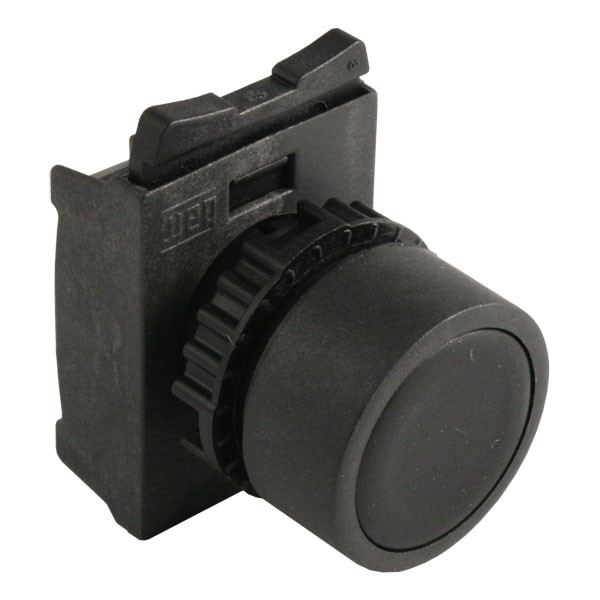A pushbutton is a control device used to manually open and close a set of contacts. Pushbuttons are available in a flush mount, extended mount, with a mushroom head, illuminated or non illuminated. Pushbuttons come with either normally open, normally closed, or combination contact blocks. The Siemens 22 mm pushbuttons can handle up to a maximum of 6 circuits. The Furnas 30 mm pushbutton can handle up to a maximum of 16 circuits.
Normally Open Pushbuttons:
are used in control circuits to perform various Pushbuttons functions. For example, pushbuttons can be used when starting and stopping a motor. A typical pushbutton uses an operating plunger, a return spring, and one set of contacts. The following drawing illustrates a normally open (NO) pushbutton. Normally the contacts are open and no current flows through them. Depressing the button causes the contacts to close. When the button is released, the spring returns the plunger to the open position.
Normally Closed Pushbuttons:
Normally closed (NC) pushbuttons are also used to open and close a circuit. In the push-button’s normal position the contacts are closed to allow current flow through the control circuit. Depressing the button opens the contacts preventing current flow through the circuit. These types of pushbuttons are momentary contact pushbuttons because the contacts remain in their activated position only as long as the plunger is held depressed.
Pushbuttons are available with variations of the contact configuration. For example, a pushbutton may have one set of normally open and one set of normally closed contacts so that when the button is depressed, one set of contacts is open and the other set is closed. By connecting to the proper set of contacts, either a normally open or normally closed situation exists.
are used in control circuits to perform various Pushbuttons functions. For example, pushbuttons can be used when starting and stopping a motor. A typical pushbutton uses an operating plunger, a return spring, and one set of contacts. The following drawing illustrates a normally open (NO) pushbutton. Normally the contacts are open and no current flows through them. Depressing the button causes the contacts to close. When the button is released, the spring returns the plunger to the open position.
Normally Closed Pushbuttons:
Normally closed (NC) pushbuttons are also used to open and close a circuit. In the push-button’s normal position the contacts are closed to allow current flow through the control circuit. Depressing the button opens the contacts preventing current flow through the circuit. These types of pushbuttons are momentary contact pushbuttons because the contacts remain in their activated position only as long as the plunger is held depressed.
Pushbuttons are available with variations of the contact configuration. For example, a pushbutton may have one set of normally open and one set of normally closed contacts so that when the button is depressed, one set of contacts is open and the other set is closed. By connecting to the proper set of contacts, either a normally open or normally closed situation exists.

No comments:
Post a Comment